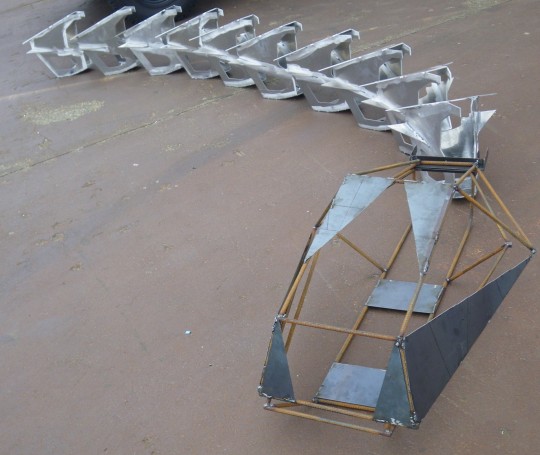TITANOBOA

60 million years ago in the sweltering heat of a climate 6 to 8 degrees warmer than today lived a monstrous snake called Titanoboa. It was only at these warmer temperatures which are at the upper end of climate change predictions that the cold blooded beast was able to reach these sizes. The Titanoboa project seeks to reincarnate this 50 foot, 1 ton beast as an amphibious, electromechanical serpent machine meant to provoke discussions of our changing climate in a historical context. This giant electromechanical reincarnation will roam the earth striking terror in the hearts of those who dare to look into its eyes and contemplate the future of our planet.
Read More...
http://titanoboa.ca/
Titanoboa meets the Mondo Spider
Video Link...
http://www.youtube.com/watch?feature=player_embedded&v=Ocyhbij9JYQ
Media
Titanoboa at Millennium Park in Calgary for Beakerhead with Momentum Live Drummers and rad BMX riders launching overhead.
Titanoboa appears at day one of Beakerhead in Calgary. We were lucky enough to cruise through Heritage Park’s “Gasoline Alley” on the way to the deployment and Michael Hall snapped some rich pictures.


Titanoboa on the Smithsonian Channel!
http://www.smithsonianchannel.com/site/sn/video/player/most-viewed/related/the-robot-monster-snake/1569348875001/
Another doozy by Ben Cooper !
A short documentary by Ben Cooper on the making of Titanoboa!
A short test run in the hangar next to eatART.
Titanoboa and the Mondo Spider walking machine doing a little dance.
20 vertebrae, 30 ft long snake in the dark on the Black Rock Roller Disco at Burning Man 2011:
10 vertebrae, 18ft long snake on the Black Rock Roller Disco at Burning Man 2011:
Video of first 10 vertebrae motion using open loop control at Vancouver 125 Summer Live event:
Video of our initial prototype:
Here’s a layup of our first 10 aluminum vertebrae with a prototype steel head:

Titanoboa appears at day one of Beakerhead in Calgary. We were lucky enough to cruise through Heritage Park’s “Gasoline Alley” on the way to the deployment and Michael Hall snapped some rich pictures.


Titanoboa on the Smithsonian Channel!
http://www.smithsonianchannel.com/site/sn/video/player/most-viewed/related/the-robot-monster-snake/1569348875001/
Another doozy by Ben Cooper !
A short documentary by Ben Cooper on the making of Titanoboa!
A short test run in the hangar next to eatART.
Titanoboa and the Mondo Spider walking machine doing a little dance.
20 vertebrae, 30 ft long snake in the dark on the Black Rock Roller Disco at Burning Man 2011:
10 vertebrae, 18ft long snake on the Black Rock Roller Disco at Burning Man 2011:
Video of first 10 vertebrae motion using open loop control at Vancouver 125 Summer Live event:
Video of our initial prototype:
Here’s a layup of our first 10 aluminum vertebrae with a prototype steel head:

More Videos...
http://titanoboa.ca/media
About Titanoboa: The Machine
Titanoboa’s Design Specifications:- Approximately 1 Ton, 50ft long, 1-3ft diameter (2011 machine = 35ft long)
- 5 different modes of motion
- 30 high strength aluminum vertebrae (2011 machine = 20 vertebrae)
- Dynamic internal lighting
- Scalable Lithium polymer battery system
- 6hp continuous, 18hp peak power
- Controllable by rider or remotely
- Multiple Arduino Mega micro controllers
- 60 proportional hydraulic cylinders (2011 machine = 40 cylinders)
- Animated eyes and Jaws
Motion:
Read More...
http://titanoboa.ca/home/about-the-machine
Titanoboa (the real snake)
From Wikipedia, the free encyclopedia
| Titanoboa Temporal range: 60–58 Ma Paleocene | |
|---|---|
 | |
| Titanoboa vertebrae (top & middle), Anaconda vertebrae (bottom). | |
| Scientific classification | |
| Kingdom: | Animalia |
| Phylum: | Chordata |
| Class: | Reptilia |
| Order: | Squamata |
| Suborder: | Serpentes |
| Family: | Boidae |
| Subfamily: | Boinae |
| Genus: | Titanoboa Head, 2009 |
| Species | |
| |
Contents[hide] |
[edit] Size
By comparing the sizes and shapes of its fossilized vertebrae to those of extant snakes, researchers estimated that the T. cerrejonensis reached a maximum length of 12 to 15 m (40 to 50 ft),[4] weighed about 1,135 kg (2,500 lb),[1] and measured about 1 m (3 ft) in diameter at the thickest part of the body.[5][6][edit] Comparison with living snakes
The largest eight of the 28 T. cerrejonensis snakes found were between 12 and 15 m (40 and 50 ft) in length. In comparison, the largest extant snakes are the Python reticulatus, which measures up to 8.7 metres (29 ft) long,[7] and the anaconda, which measures up to 5.21 metres (17 ft) long[7] and is considered the heaviest snake on Earth. At the other end of the scale, the smallest extant snake is Leptotyphlops carlae with a length of about 10 centimetres (4 in).[8][edit] Location
In 2009, the fossils of 28 individual T. cerrejonensis were announced to have been found from the Cerrejón Formation in the coal mines of Cerrejón in La Guajira, Colombia.[1][2] Prior to this discovery, few fossils of Paleocene-epoch vertebrates had been found in ancient tropical environments of South America.[9] The snake was discovered on an expedition by a team of international scientists led by Jonathan Bloch, a University of Florida vertebrate paleontologist, and Carlos Jaramillo, a paleobotanist from the Smithsonian Tropical Research Institute in Panama.[10][edit] Climate
Because snakes are ectothermic, the discovery implies that the tropics, the creature's habitat, must have been warmer than previously thought, averaging approximately 30 °C (90 °F).[1][2][11][12] The warmer climate of the Earth during the time of T. cerrejonensis allowed cold-blooded snakes to attain much larger sizes than modern snakes.[13] Today, larger ectothermic animals are found in the tropics, where it is hottest, and smaller ones are found further from the equator.[3][edit] References
- ^ a b c d Head, Jason J.; Jonathan I. Bloch, Alexander K. Hastings, Jason R. Bourque, Edwin A. Cadena, Fabiany A. Herrera, P. David Polly, and Carlos A. Jaramillo (2009). "Giant boid snake from the paleocene neotropics reveals hotter past equatorial temperatures.". Nature 457 (7230): 715–718. doi:10.1038/nature07671. PMID 19194448. http://www.nature.com/nature/journal/v457/n7230/abs/nature07671.html. Retrieved 2009-02-05.
- ^ a b c d Kwok, Roberta (4 February 2009). "Scientists find world's biggest snake". Nature. http://www.nature.com/news/2009/090204/full/news.2009.80.html. Retrieved 2009-02-04.
- ^ a b "Science Daily: At 2,500 Pounds And 43 Feet, Prehistoric Snake Is Largest On Record". ScienceDaily. 2009-02-04. http://www.sciencedaily.com/releases/2009/02/090204112217.htm. Retrieved 2009-02-06.
- ^ "CTV.ca | Ancient, gargantuan snakes ate crocs for breakfast". http://www.ctv.ca/servlet/ArticleNews/story/CTVNews/20090204/snake_biggest_090204/20090204?hub=SciTech. Retrieved 2009-02-07.
- ^ McIlroy, Anne (2009-02-05). "Titanoboa made anaconda look like a garter snake". Science. http://www.theglobeandmail.com/servlet/story/RTGAM.20090205.wsnake05/BNStory/Science/home. Retrieved 2009-02-06.
- ^ Dunham, Will (2009-02-04). "Titanic ancient snake was as long as Tyrannosaurus". Reuters UK. http://uk.reuters.com/article/oddlyEnoughNews/idUKTRE5136K320090204. Retrieved 2009-02-06.
- ^ a b Murphy JC, Henderson RW. 1997. Tales of Giant Snakes: A Historical Natural History of Anacondas and Pythons. Krieger Pub. Co. 221 pp. ISBN 0894649957.
- ^ S. Blair Hedges (August 4, 2008). "At the lower size limit in snakes: two new species of threadsnakes (Squamata: Leptotyphlopidae: Leptotyphlops) from the Lesser Antilles" (PDF). Zootaxa 1841: 1–30. http://www.mapress.com/zootaxa/2008/f/zt01841p030.pdf. Retrieved 2008-08-04.
- ^ Maugh II, Thomas H. (4 February 2009). "Fossil of 43-foot super snake Titanoboa found in Colombia". Los Angeles Times. http://www.latimes.com/news/nationworld/world/la-sci-snake5-2009feb05,0,6550292.story. Retrieved 2009-02-04.
- ^ "At 2,500 Pounds And 43 Feet, Prehistoric Snake Is Largest On Record". Science Daily. February 4, 2009. http://www.sciencedaily.com/releases/2009/02/090204112217.htm. Retrieved 2009-02-04.
- ^ Joyce, Christopher (5 February 2009). "1-Ton Snakes Once Slithered In The Tropics". NPR. http://www.npr.org/templates/story/story.php?storyId=100262412. Retrieved 2009-02-05.
- ^ "ScienceDirect - Palaeogeography, Palaeoclimatology, Palaeoecology : Climate model sensitivity to atmospheric CO2 levels in the Early–Middle Paleogene". http://www.sciencedirect.com/science?_ob=ArticleURL&_udi=B6V6R-47S6RC4-3&_user=10&_rdoc=1&_fmt=&_orig=search&_sort=d&view=c&_acct=C000050221&_version=1&_urlVersion=0&_userid=10&md5=f53378580e88505b71158a35999e10ef. Retrieved 2009-02-07.
- ^ Makarieva, A. M.; Victor G. Gorshkov and Bai-Lian Li (2005-09-14). "Gigantism, temperature and metabolic rate in terrestrial poikilotherms". Proceedings of the Royal Society B 272 (1578): 2325–2328. doi:10.1098/rspb.2005.3223. PMC 1560189. PMID 16191647. http://journals.royalsociety.org/content/p30384h277127964/. Retrieved 2009-02-07.
[edit] External links
 | Wikimedia Commons has media related to: Titanoboa |
- A Snake the Size of a Plane: How did prehistoric animals get so big? By Nina Shen Rastogi. Feb. 5, 2009.
| ||
Go there...
http://en.wikipedia.org/wiki/Titanoboa
Titanoboa Mechanical Snake-bot
- Snake-bot gives us the mechanical heevy-jeevies - Hack a Day
- Titanoboa meets the Mondo Spider - YouTube
- 50ft Electromechanical Snake Titanoboa!
- Mondo Spider - Hack a Day
- Titanoboa - Wikipedia, the free encyclopedia
- About Titanoboa: Learn About the Machine — Titanoboa
- Media - Titanoboa — Titanoboa
- bummeroo's Channel - YouTube


No comments:
Post a Comment